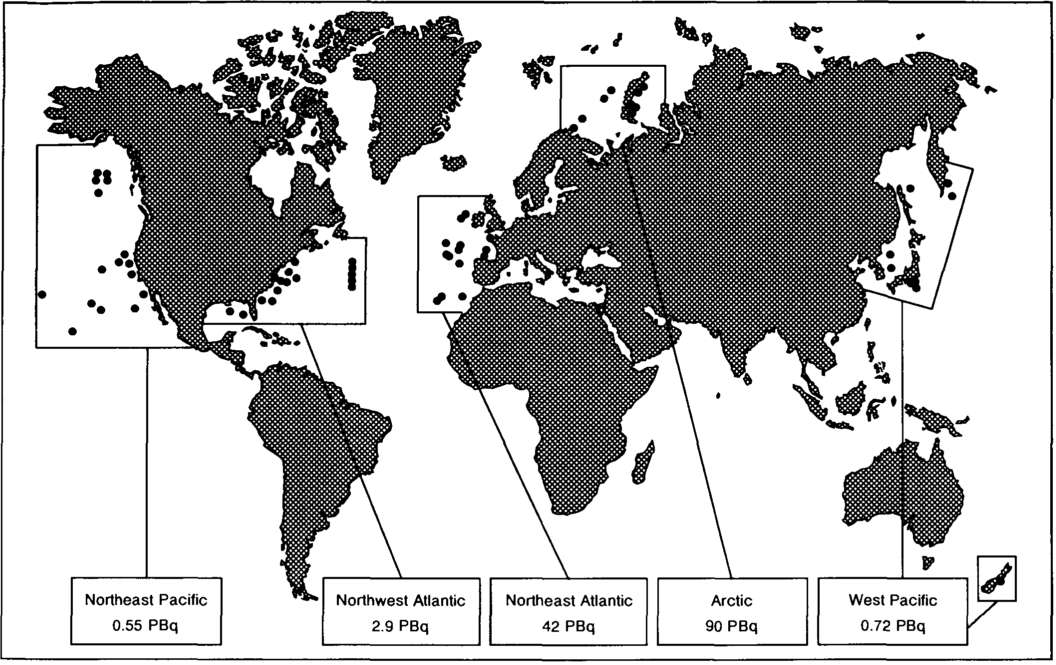I have been blogging about illegal dumping of nuclear wastes by and in different countries. Some of the articles have contained references to ocean dumping of wastes. There have been various international treaties signed intended to stop such practices including the London Convention of 1972 which went into effect in 1975.
The first recorded dumping of radioactive materials occurred in 1946 off the coast of California. Over the years, at least thirteen countries have dump radioactive materials into the world's oceans. The dumping consists of three different types. Type one is liquid low-level wastes. The second type is solid low-level waste in containers and the third is reactor vessels with or without nuclear fuel. About two thirds of the radioactivity that has been dumped into the oceans comes from of six submarine reactors and one reactor from an icebreaker dumped by the Soviet Union into the Arctic Sea. The remaining third is mainly from low-level waste dumped by eight European nations into the north Atlantic. Waste has also been dumped into the Sea of Japan and parts of the Pacific Ocean by several different nations.
The London Convention was based on a black list and a grey list of toxic wastes including radioactive waste. High-level radioactive wastes were on the black list and signatories were prohibited from dumping such wastes in the ocean. Intermediate-level and low-level nuclear wastes were on the grey list and could be dumped as long as a permit was issued by the nation where the wastes originated. The International Atomic Energy Agency published guidelines for what areas of the world's oceans could be used for such dumping as well as minimum depth for dumping. Although the Soviet Union signed the Convention in 1975, they regularly dumped high-level radioactive waste into the Arctic Sea and violated the recommendations of the IAEA.
Following the London Convention, other treaties were signed to prohibit all dumping of radioactive waste into designated bodies of water. In 1974, the Baltic Sea was placed off limits to dumping; in 1976, the Mediterranean Sea was prohibited; in 1985, areas of the South Pacific Ocean were prohibited; in 1989, the Southeast Pacific Ocean was prohibited and in 1992, the Black Sea was prohibited.
In 1985, the signatories of the London Convention met to consider the issue of radioactive dumping into the remaining world's oceans and seas. They decided to call for a voluntary moratorium on any dumping of radioactive wastes into the oceans. At a meeting in 1986, a panel was convened to consider the political, legal, social, economic and technical issues connected to ocean dumping. A series of reports was issued by the panel in the next few years.
In 1993, another meeting of the London Convention signatories concluded that, partly based on the reports issued by the panel, all ocean dumping of any type of radioactive waste would be prohibited starting in 1994. Despite the agreement to stop ocean dumping, reports have charged that the Italian Mafia has been illegally dumping radioactive wastes into the ocean off the south coast of Italy and off the east African coast near Somalia. As with all treaties involving prohibited behavior, the problem is detection of violations and punishment of violations. The biggest current problem with the world's oceans and radioactive materials is, of course, the huge amount of radioactive contamination flooding into the north Pacific from the Fukushima disaster. Unfortunately, it has been very difficult for Japan to halt this pollution of the Pacific, regardless of promises made in international treaties.
Areas of the world's oceans where radioactive materials have been dumped:
